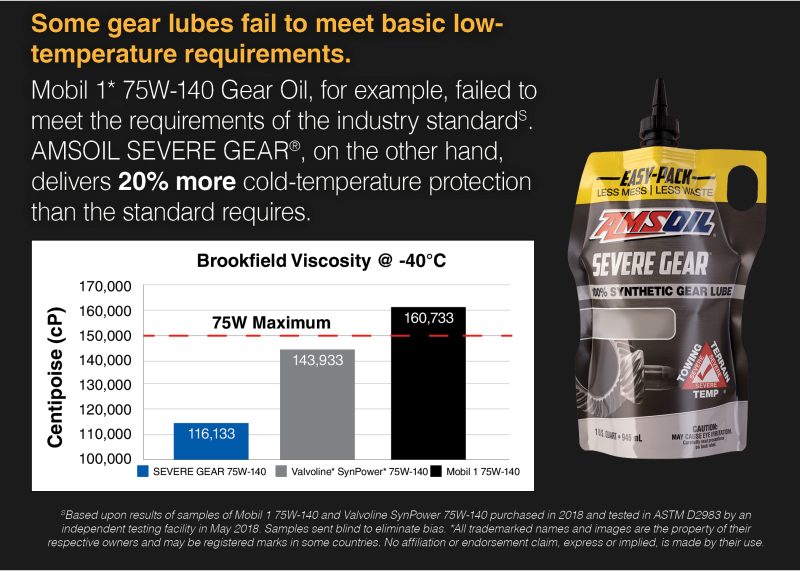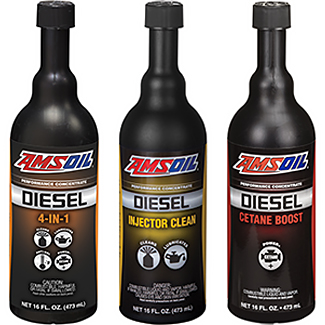Vehicle maintenance is an important part of preparing for winter months. Extreme winter weather can make breakdowns especially dangerous, and most people aren’t aware of the effect cold weather has on conventional lubricants.
An oil’s cold-temperature performance refers to its ability to flow when the engine is cold, or below typical operating temperature (212°F), and not simply to what feels cold to humans. In other words, warm summer days are also cold to an engine. Startup lubrication is directly affected by a lubricant’s cold flow ability, and the negative impact happens at warmer temperatures than most consumers would think.
For example, in early 1991, General Motors* halted sales of the Corvette* ZR-1 because eight engines had seized at the Bowling Green assembly plant in Kentucky. The temperature had only dipped to slightly below freezing and at startup the hard-to-pump motor oil did not reach the front camshaft bearings, which were destroyed by lack of lubrication. GM responded by requiring the use of synthetic oil in the Corvette.
Fortunately, there are ways to help prevent the damaging effects of cold starts:

Motor Oil
Most engine wear occurs at startup. Cold temperatures can render oil so thick it cannot flow through narrow passageways to protect critical components, increasing wear. The natural paraffin wax in conventional oil makes the problem worse as it solidifies quickly in freezing temperatures.
AMSOIL synthetic motor oils contain no paraffins, remaining fluid in frigid winter temperatures (down to -63°F) for easier starting, improved oil flow and excellent engine protection. Their unique synthetic formulations allow them to flow in extreme cold while also maintaining high film strength in extreme heat for outstanding protection all year.

Transmission Fluid
Transmission fluids are also affected by cold temperatures. Since transmission fluid’s ability to flow does not directly impact a vehicle’s ability to start, most consumers do not even consider cold-temperature transmission fluid performance, but it does impact performance and wear.
Automatic transmissions can shift harder in the cold, but changes in transmission performance brought on by cold temperatures are usually more pronounced for drivers who operate manual transmissions. As transmission fluid thickens in the cold, the synchronizers in manual transmissions cannot spin as quickly as they need to, which can severely impact the driver’s ability to shift until the fluid is warmed enough to provide proper flow and protection.
AMSOIL transmission fluids are wax-free and deliver extraordinary cold-flow properties. They help improve shift response, energy efficiency and overall cold-weather performance.

Gear Oil
Gear oils with high viscosity at cold temperatures are less efficient because the gears require more energy to turn, resulting in reduced fuel economy. Gears and bearings in the differential and axle housing are splash-lubricated, so gear lubricants that are too thick at cold temperatures can starve the internal components of lubrication, which can cause gear failure.
AMSOIL synthetic gear oil has outstanding cold-flow properties for maximum fuel economy and smooth cold-weather gear operation.

Diesel Fuel
As the temperature drops, the naturally occurring wax in diesel fuel begins to crystallize. The point at which wax crystals form is known as the cloud point. These wax crystals eventually clog the fuel filter and starve the engine of fuel, preventing it from starting. While low-quality fuels may form wax crystals in temperatures as warm as 40ºF (4ºC), most fuels have a cloud point near 32ºF (0ºC). The point at which the crystals clog the fuel filter is known as the cold filter-plugging point (CFPP).
AMSOIL Diesel Cold Flow lowers the CFPP by up to 20ºF (15ºC) in ultra-low-sulfur diesel fuel (ULSD). It uses a jet-fuel-type deicer that disperses water to control ice formation throughout the fuel system. AMSOIL Diesel Cold Flow also inhibits wax crystal formation, allowing fuel to flow to the engine more easily and improving diesel engine reliability in cold temperatures.
AMSOIL Diesel 4-IN-1 combines the benefits of AMSOIL Diesel Cold Flow, Diesel Injector Clean and Diesel Cetane Boost in one convenient package.
But what if your diesel fuel has already gelled?
AMSOIL Diesel Recovery quickly liquefies gelled diesel fuel and thaws frozen fuel filters in engines that haven’t been treated with AMSOIL Diesel Cold Flow, to help get you back on the road. Keep a bottle in your diesel-engine vehicle all winter long!
Did you know?
AMSOIL Dominator® Coolant Boost significantly reduces engine warm-up times in cold weather. You can enjoy warm air from your vehicle’s heater faster on cold winter days by adding Coolant Boost to the radiator.











Comments
AMSOIL Technical Writer and 20-year veteran of the motorcycle industry. Enjoys tearing things apart to figure out how they work. If it can’t be repaired, it’s not worth owning.
Share: